How to Roll Inside-Out Sushi Rolls (Uramaki)
Learn how to roll sushi with rice on the outside (inside-out sushi rolls or uramaki) with step-by-step instructions. Or jump straight to the recipe for avocado and cucumber inside-out sushi rolls.
Uramaki (or inside-out sushi rolls) are not traditional Japanese sushi rolls. But they are delicious and fun to make at home.
Keep reading to learn more about different types of sushi rolls and how to roll your sushi with rice on the outside. Or jump to the recipe card for avocado and cucumber inside-out sushi rolls.
Experiment with different ingredients to fill your uramaki sushi. Try raw fish, cooked shellfish, and imitation crab meat, or stick to veggies as I do.
Cover the inside-out rolls with sesame seeds or fish roe. And serve your homemade sushi with soy sauce, wasabi paste and pickled ginger.
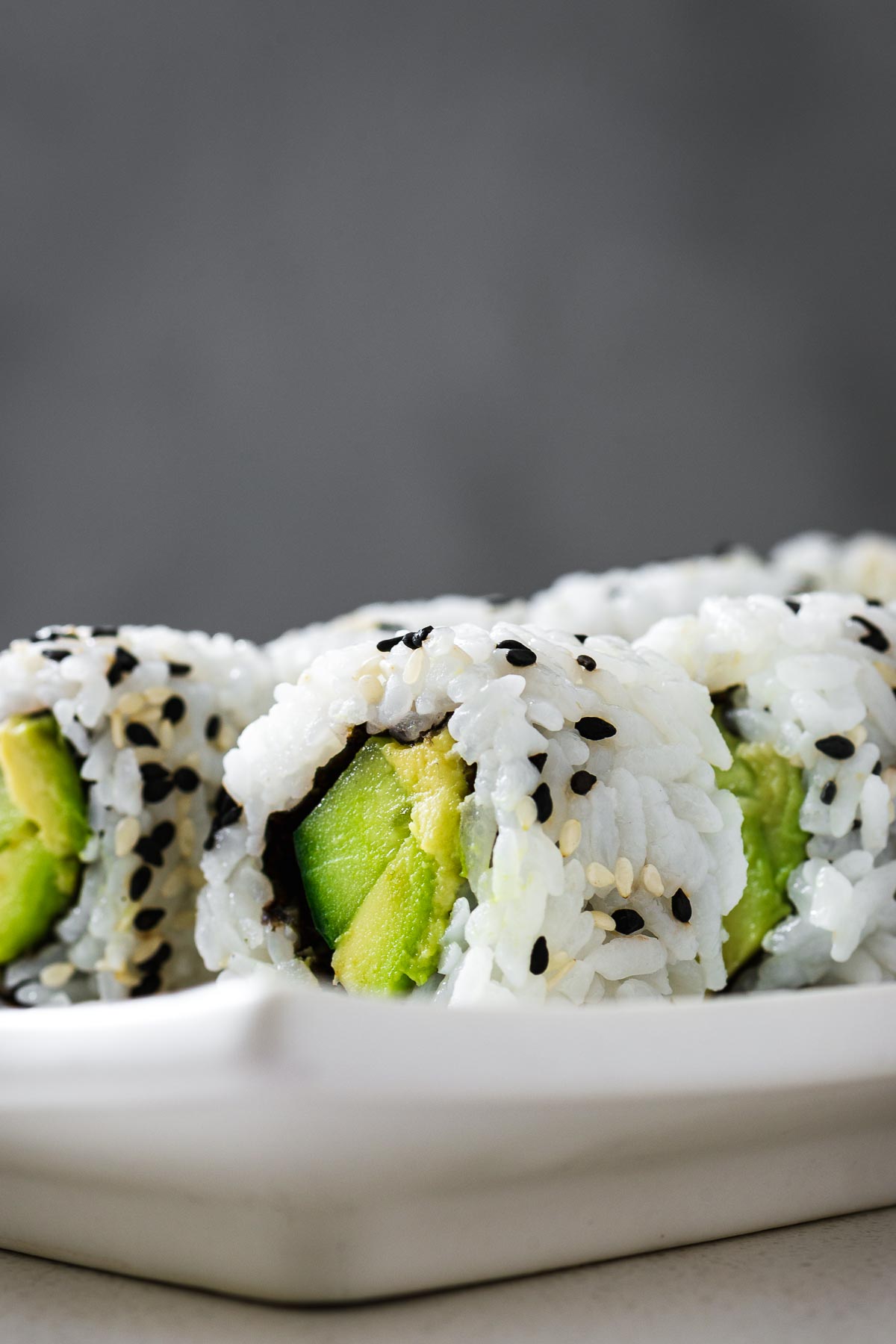
Uramaki vs norimaki
Simply put, uramaki are sushi rolls with rice on the outside, whereas norimaki has roasted nori on the outside.
What is uramaki?
Uramaki is an inside-out roll with rice on the outside of the nori. Fillings are at the centre of the roll. And the outside rice can have additional toppings like fish roe, sesame seeds or thinly sliced raw fish or avocado.
Inside-out rolls are common in the United States. California rolls and dragon rolls are examples of popular US inside-out rolls.
In Japan, you don’t need chopsticks for sushi. You can pick up sushi rolls with your clean fingers. And due to the sticky rice on the outside, uramaki rolls are not practical finger food. They are also not traditional Japanese sushi rolls.
What is norimaki?
Norimaki refers to various Japanese rice dishes wrapped in seaweed – unlike uramaki, which is a sushi roll with rice on the outside.
Norimaki include makizushi (or makimono). These sushi rolls consist of a filling surrounded by rice wrapped in an outer layer of nori.
Two types of makimono are:
- Hosomaki, which translates to thin roll. It typically has only one filling ingredient.
- Futomaki are thicker than hosomaki with multiple filling ingredients.
Try this easy avocado sushi roll recipe to learn how to roll avocado hosomaki. Hosomaki are even easier to make than uramaki, so it’s a great place to start if you want to hone your sushi rolling skills.
What you’ll need for uramaki rolls
Making simple uramaki rolls at home is easy. And you require only a few tools for successful homemade inside-out rolls.
A bamboo mat (makisu)
Some authentic makisu have a green side and a flatter white side. But you can use any bamboo mat.
Or, if you don’t have a sushi mat, use a firm yet bendable placemat.
Plastic wrap
Inside-out sushi rolls have rice on the outside – rice touches the mat as you roll. So, it’s easiest to cover your bamboo sushi mat with cling film to avoid the rice sticking to the bamboo mat.
You can also use a slightly wet sushi mat instead. But the cling wrap makes life a bit easier.
A sharp knife
A very sharp knife can slice the sushi rolls into bite-sized pieces without squashing them. And wetting the blade as you go keeps the rice from sticking to it.
A cutting board
Any clean cutting board will do. Use it to prepare your ingredients and slice your rolls.
A small bowl of water
Get a bowl of room-temperature water and wet your hands if the rice sticks to them.
Also, use the water to clean your knife between slices.
A damp tea towel
Cover your prepared sushi rice with a clean damp towel to keep it moist.
You can also use the towel to wipe away starch from your knife.
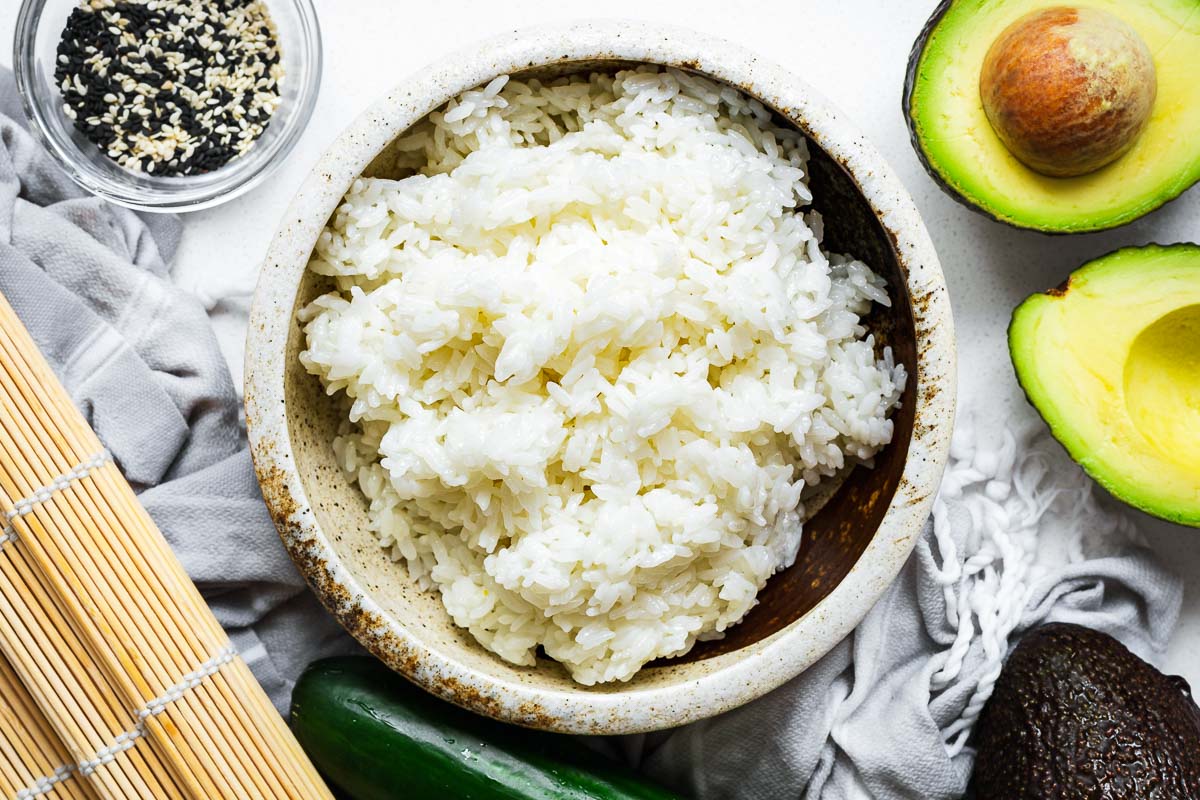
Typical uramaki ingredients
In the step-by-step instructions, I make simple avocado and cucumber inside-out vegan sushi rolls.
Let your imagination run wild with the filling and topping ingredients. But make sure you use the best rice for sushi. And season it with sushi vinegar for traditional Japanese vinegared rice.
Nori sheets
Nori is a dried edible seaweed sheet ubiquitous in Japanese cuisine.
As you roll, aim to connect the rice around the nori sheet and sushi filling – without a spiral of nori. Use a half-sized nori sheet for perfect inside-out sushi rolls with rice on the outside.
The roasted seaweed sheets are approximately 18 cm × 20 cm (7 in × 8 in). Cut each sheet in half on the long side. So, each nori sheet will produce two pieces – roughly 18 cm × 10 cm (7 in × 4 in) each.
But you can leave the nori sheet whole if you want a super thick roll with a spiral of nori running through the middle. Though, it may no longer be bite-sized.
Sushi rice
Sushi rice is sticky short-grain rice seasoned with sushi vinegar. But you can also use medium-grain rice. One cup of uncooked sushi rice yields roughly two and a half cups of cooked rice.
Sushi vinegar is a mixture of rice vinegar, cane sugar and salt.
Cook one cup of sushi rice, following the package instructions, and season it with three tablespoons of shop-bought sushi vinegar or a homemade vinegar mixture.
For step-by-step sushi rice instructions, see the recipe for the best stovetop sushi rice (with rice cooker instructions) or the Instant Pot sushi rice recipe. Both recipes include instructions for homemade sushi vinegar.
Cover your prepared sushi rice with a damp tea towel as it cools down to room temperature.
Fillings
Inside-out rolls are not traditional Japanese sushi. Authentic Japanese sushi rolls are bite-sized rolls you can pick up with your fingers (instead of chopsticks). The rice on the outside makes uramaki sticky and difficult to pick up with your fingers.
And because inside-out sushi rolls are not traditionally Japanese, you can really let your imagination run wild. Fill the sushi rolls with what you have.
Try California rolls with imitation crab meat (or crabsticks) and avocado. Sprinkle the rolls with sesame seeds or fish roe.
Or add slices of sushi-grade fish, cucumber batons, and avocado slices to the centre of your roll. And drizzle spicy mayo over your finished rolls. For spicy mayo, mix equal parts sriracha with mayonnaise.
If you want to experiment with a vegan combination, try the easy vegan sushi rolls with avocado and cucumber in the recipe card.
How to roll sushi with rice on the outside
This section has step-by-step directions (with pictures) for how to roll sushi with rice on the outside, i.e. inside-out rolls or uramaki. Or jump straight to the recipe card for the easy vegan sushi rolls recipe (avocado and cucumber inside-out rolls).
Steps to roll sushi with rice on the outside:
- Step 1: Prep your equipment
- Step 2: Prep your ingredients
- Step 3: Add sushi rice and fillings
- Step 4: Roll the sushi into a log (with rice on the outside)
- Step 5: Cut the roll with a sharp knife
Step 1: Prep your equipment
Fill a small bowl with cold water to wet your hands as you go.
You can cover your bamboo sushi mat in cling film. It makes cleaning easier. And if you use a new piece of cling wrap for each sushi log, it can also make cutting the sushi easier.
Step 2: Prep your ingredients
Cook your sushi rice, season it with sushi vinegar, and cover it with a damp kitchen towel or cloth. Allow it to cool to room temperature before using.
It is best to cook your sushi rice two hours before you want to start assembling the sushi. It allows enough time for the rice to cool to room temperature.
See how to cook sushi rice (stovetop) or Instant Pot sushi rice for more detailed instructions.
Next, cut each nori sheet into two pieces. Nori sheets are not perfectly square. A nori sheet is roughly 18 cm × 20 cm (7 in × 8 in). Cut your nori by cutting the longer side in half. Each nori sheet will produce two pieces, roughly 18 cm × 10 cm (7 in × 4 in).
Cut your ingredients into strips. I aim for roughly 1 cm (½ inch) thick strips. Play around until you find what works best for you.
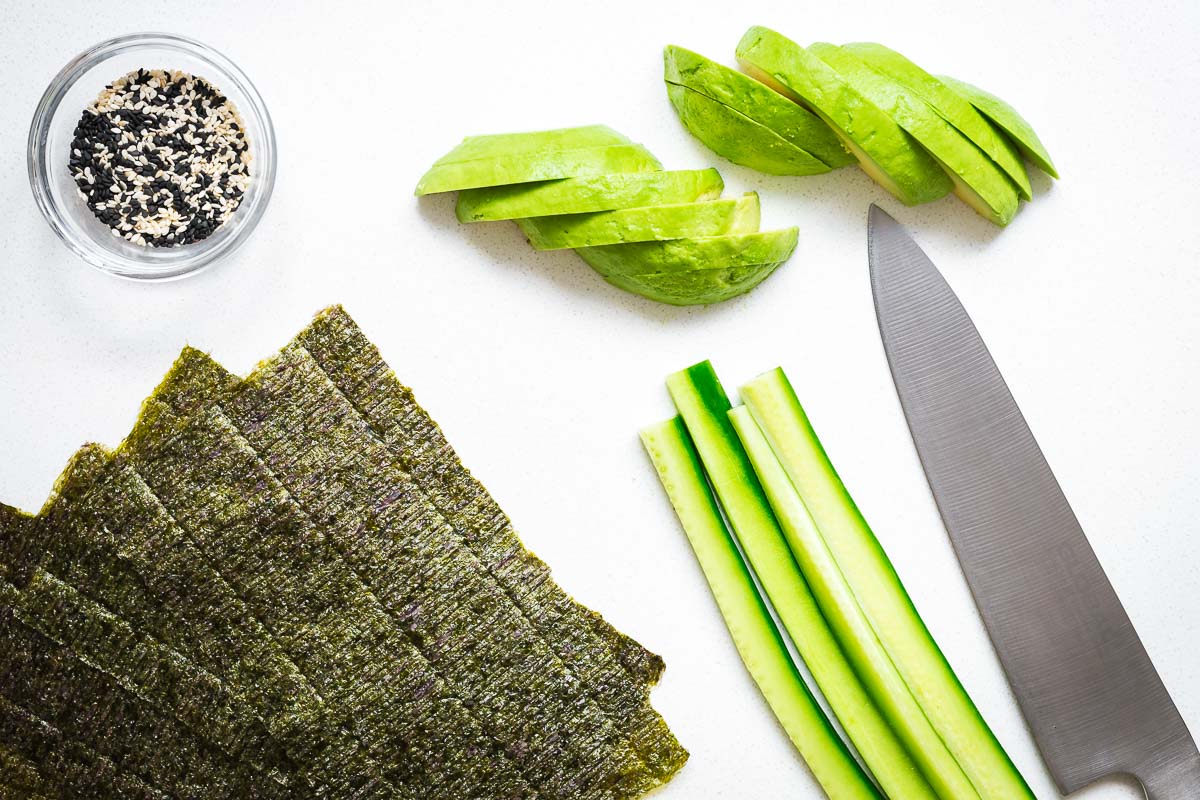
Step 3: Add sushi rice and fillings
Place the half sheet of nori towards the bottom of your bamboo mat with the longest edge facing you. The rough side should be facing up.
Start with half a cup of sushi rice (about 80 grams) and spread it in an even layer. Add more rice, as needed, until the nori sheet is covered from edge to edge.
Sprinkle the rice with sesame seeds or fish roe.
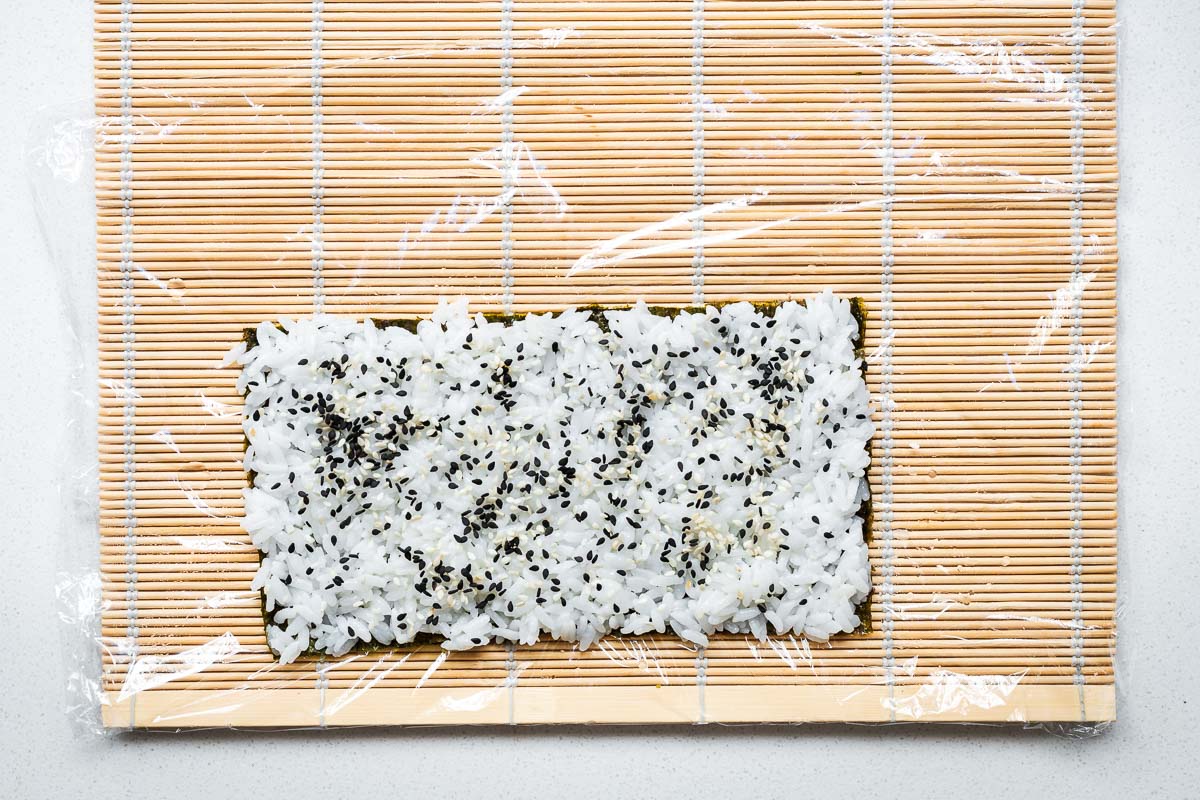
Now, flip the nori sheet so that the rice is on the bottom – touching the plastic wrap-covered bamboo mat.
Arrange your ingredient in horizontal lines on top of the nori. Add two to three lines of different sliced ingredients.
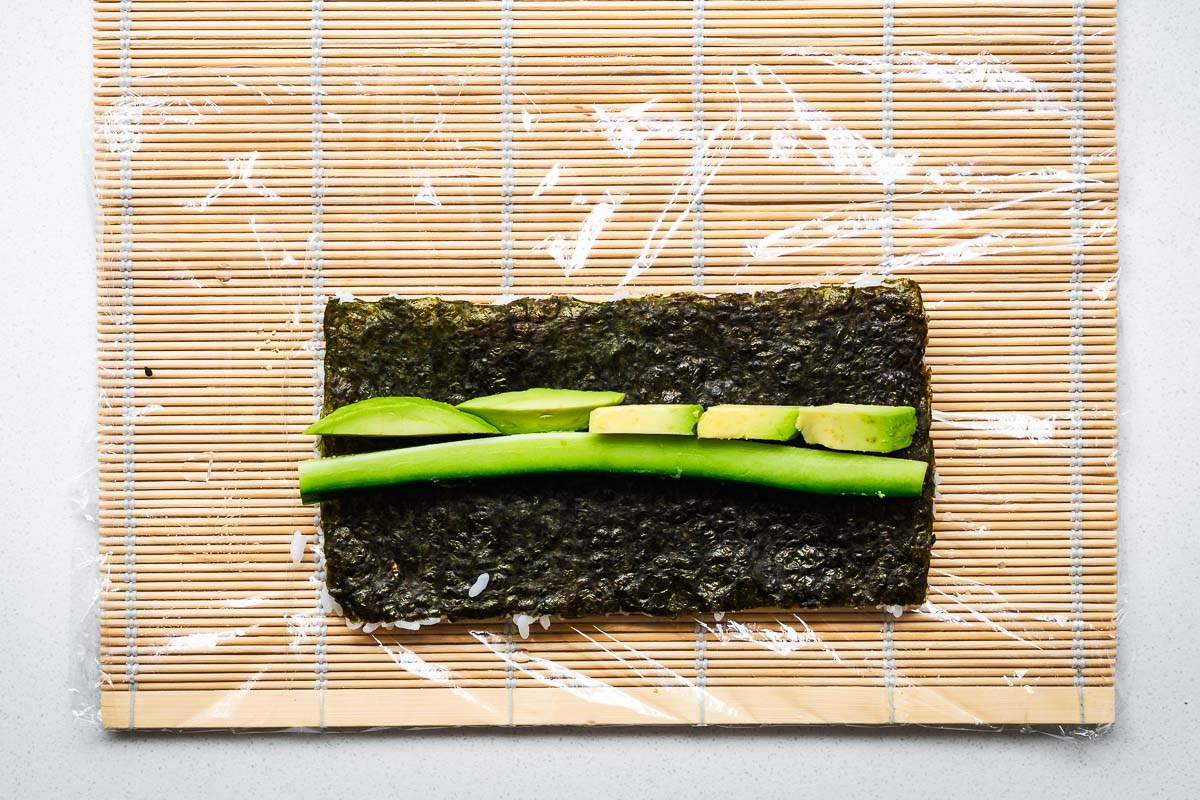
Step 4: Roll the sushi into a log
Slide the nori sheet all the way to the bottom of the sushi mat.
Lift the bottom edge of the bamboo mat with your thumbs to roll the nori and rice around the filling.
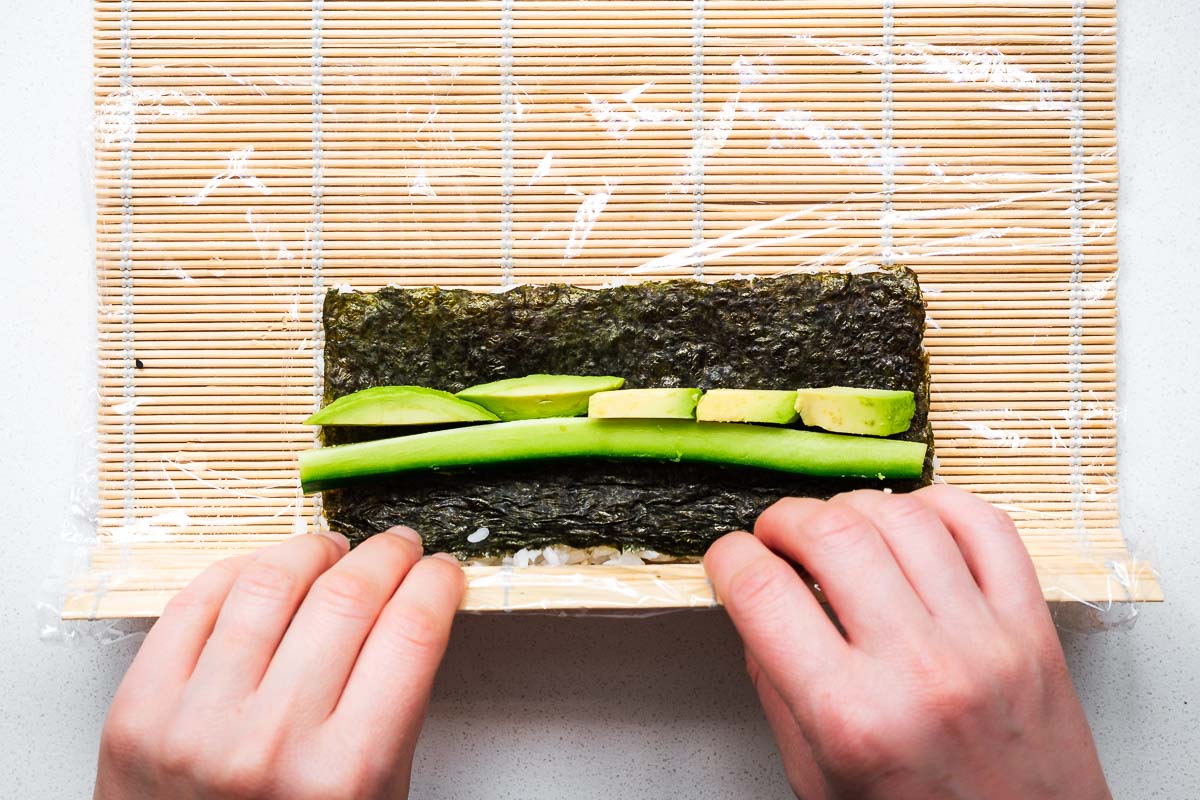
Use your index and middle fingers to keep the filling in place as you roll. Keep going until the rice connects.
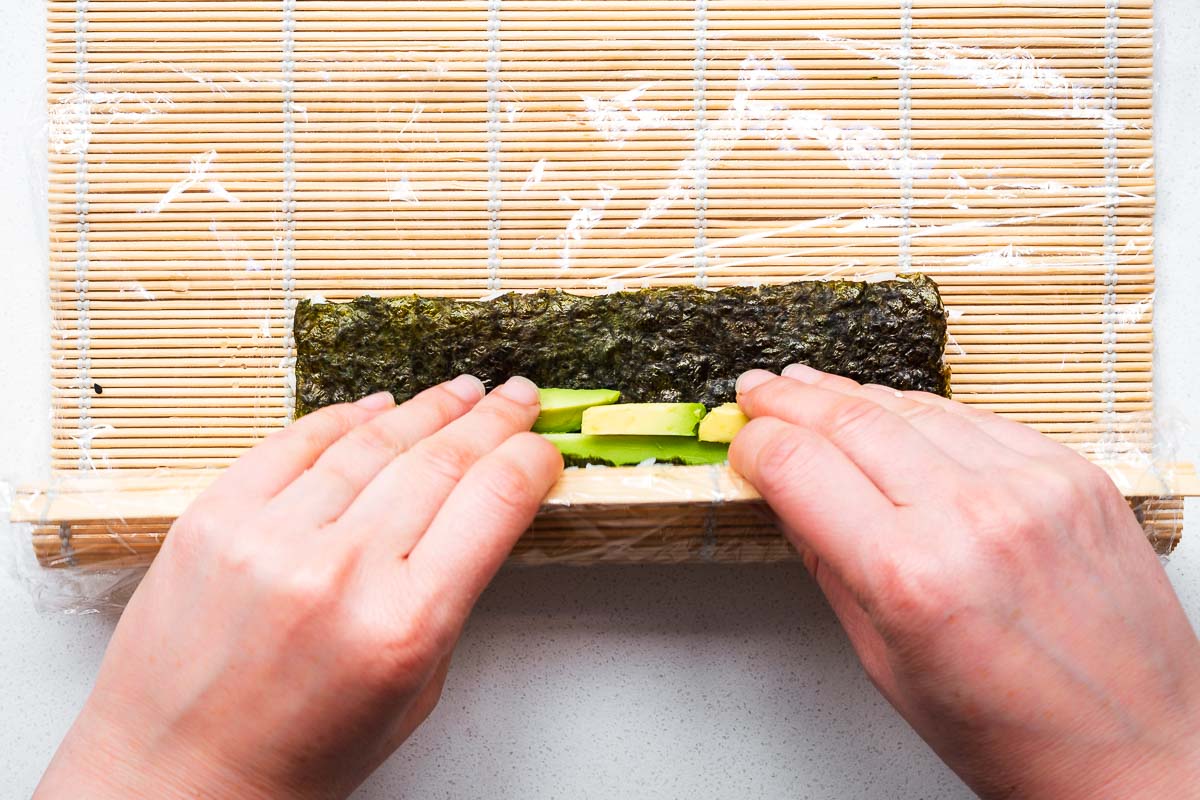
Use your mat to tighten the shape. Press the ends to even any ingredients poking out.
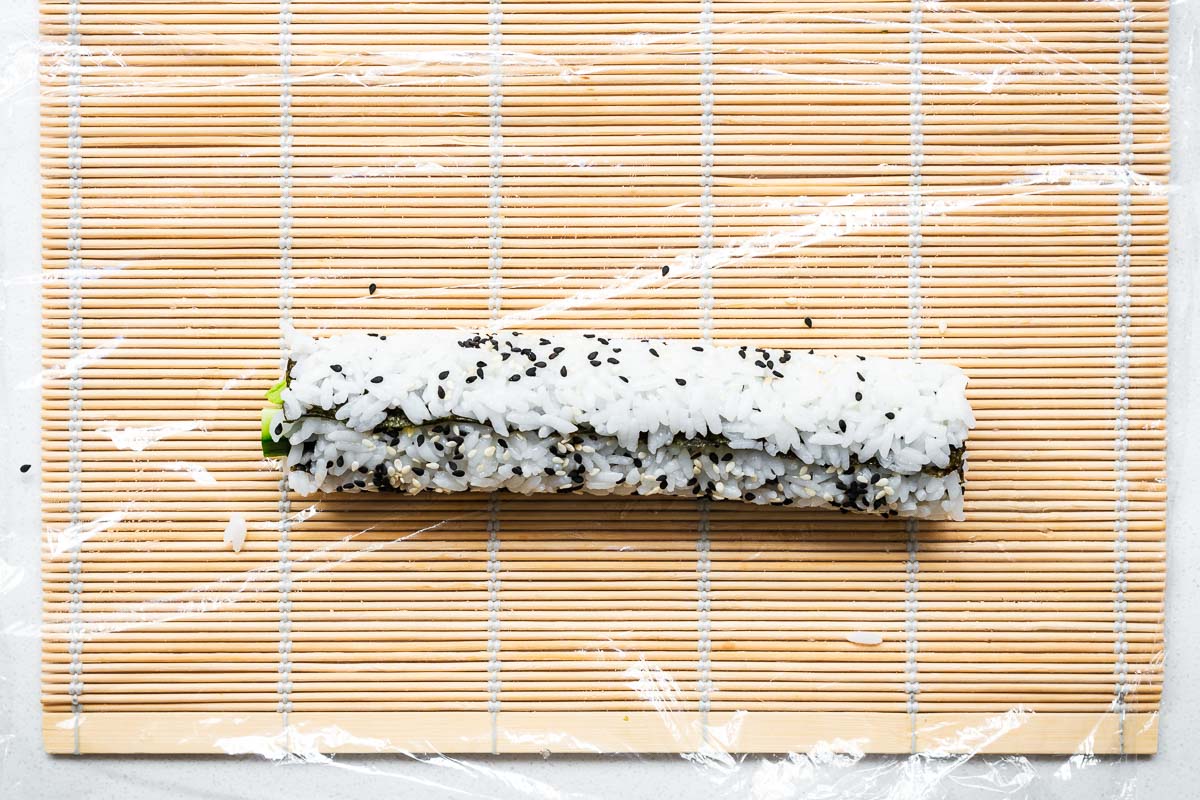
Step 5: Cut the sushi
Uramaki rolls are typically cut into eight bite-sized pieces.
Transfer your sushi log to the cutting board. Take your sharp knife and carefully wipe it with a clean wet kitchen towel (or dip it in the water).
Slice a sushi log in half. Then slice each half-roll into four equal sizes. Wipe the knife clean between slices or if it feels sticky.
If you are worried about squashing the sushi rolls as you slice, you can leave the cling wrap around the sushi. Tighten the plastic wrap around the sushi and cut through the plastic. It keeps the sushi roll intact as you slice, but it unfortunately requires more cling wrap.
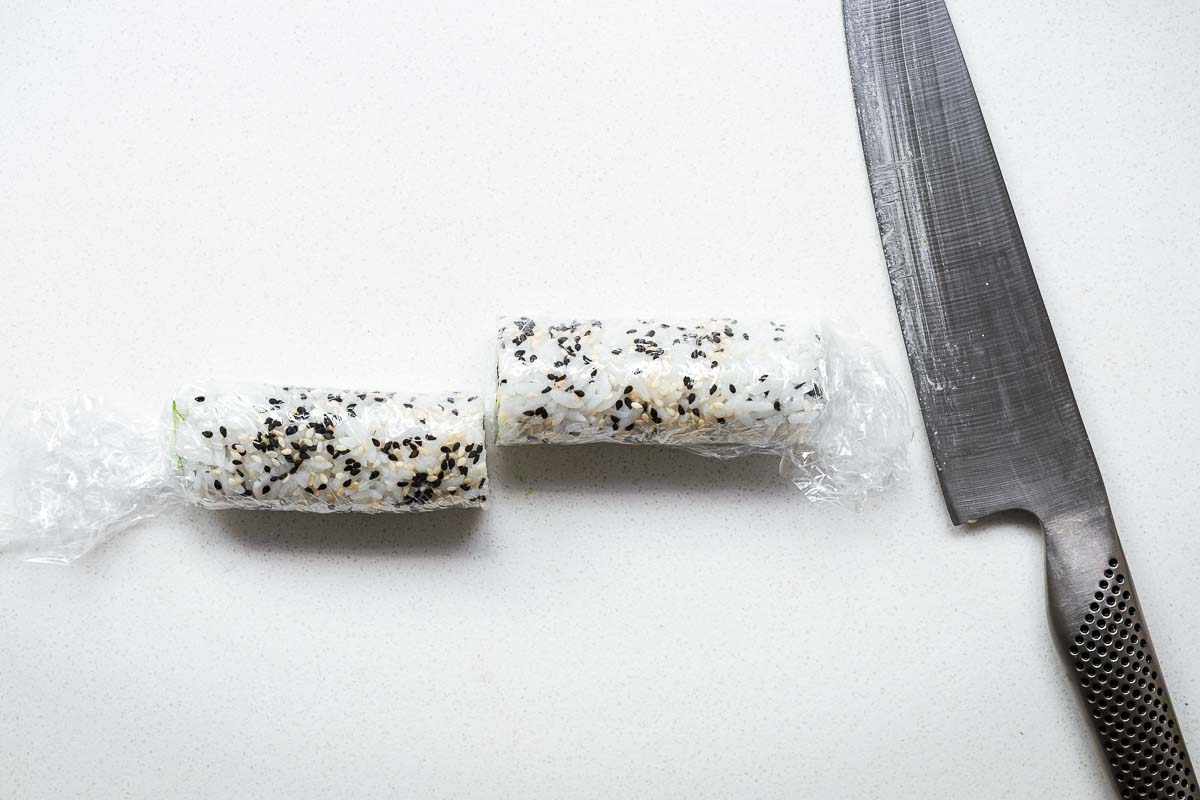
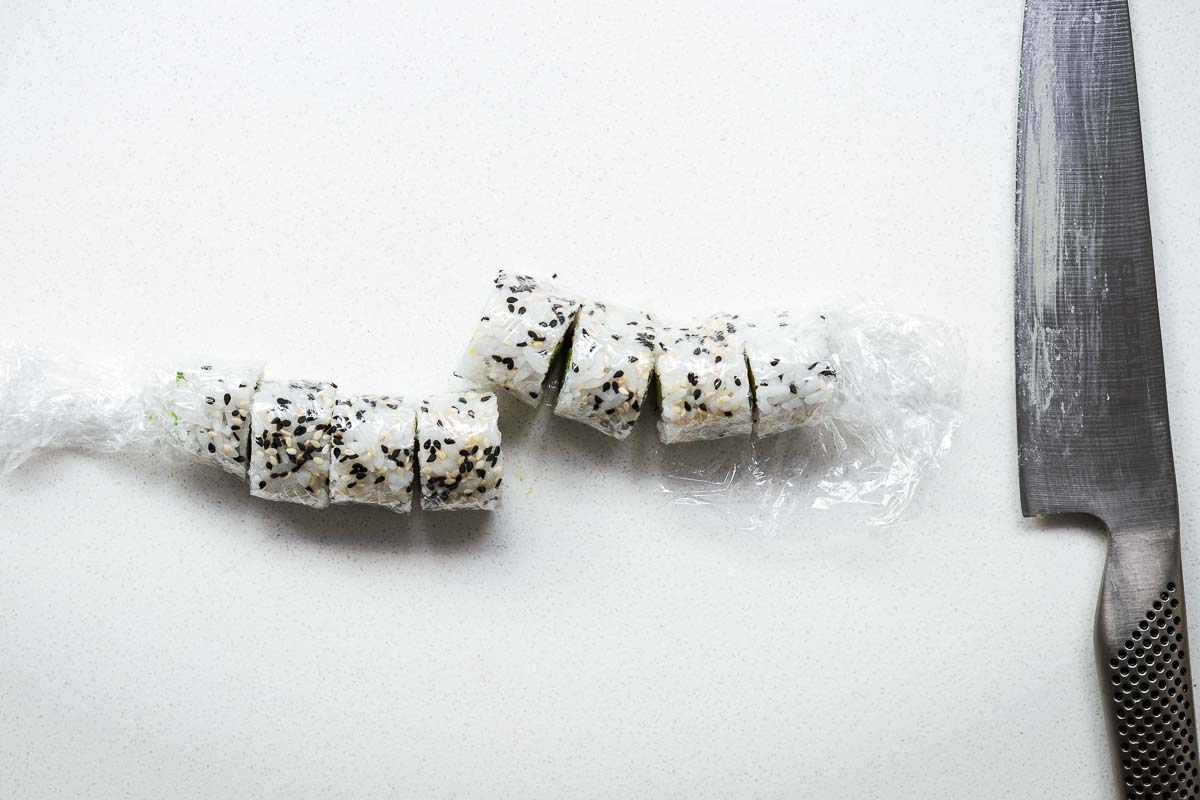
You can use the mat to do some final shaping after cutting.
Discard the plastic wrap and serve your homemade uramaki with soy sauce, wasabi paste and sushi ginger.
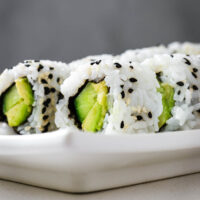
Equipment
Ingredients
- 2 ½ cups prepared sushi rice, room temperature*
- 3 nori sheets
- 3 tablespoons sesame seeds
Filling options
- cucumber, deseeded and sliced into batons
- avocado, peeled and sliced into strips
- imitation crab or crab sticks
- raw sushi-grade fish, like salmon or tuna, sliced into strips
To serve (optional)
- soy sauce
- wasabi paste
- pickled sushi ginger
- kewpie mayo, or spicy mayo
Instructions
Prep your equipment
- Fill a small bowl with room-temperature water to wet your hands as you go.
- And use a piece of plastic wrap to cover your bamboo sushi mat.
Prep your ingredients
- Each nori sheet can make two rolled logs. And nori sheets are not perfectly square. So, cut each nori sheet by cutting the longer side in half.
- Slice all your filling ingredients into strips – roughly 1 cm (½ inch) thick.
Add the rice and fillings
- Place a half sheet of nori towards the bottom of the bamboo mat with the longest edge facing you. The rough side should be facing up.
- Place a handful of cooked rice on the rough side of the nori (that is facing up) – roughly ½ US cup or 80 grams of rice.
- Spread the rice to cover the nori sheet. Wet your hands if the rice sticks to them.
- Add more rice until you have an even layer of rice. Sprinkle the rice with ½ tablespoon of sesame seeds and gently press down with wet hands to let them stick to the rice.
- Carefully flip the nori sheet so the rice is on the bottom – touching the plastic-covered bamboo mat.
- Arrange your sliced fillings in the centre of the rice, creating horizontal strips. Add two to three rows of filling.
Roll the sushi
- Lift the bottom edge of the sushi mat to gently roll the rice and nori around the filling, connecting the rice.
- Use the bamboo mat to tighten your roll.
Cut the sushi
- Typically, uramaki gets cut into 8 equal-sized pieces.
- Wipe the blade of a sharp knife with a clean wet kitchen towel (or dip it into the bowl of water). Slice a sushi roll in half. Then slice each half-roll into four equal sizes. Wipe the knife clean between slices or if it feels sticky.
- You should have 8 even bite-sized pieces of sushi.
Serve the sushi
- Arrange the avocado sushi rolls on a platter. Add dollops of kewpie mayo or drizzle with spicy sriracha mayo.
- Serve it with a bowl of soy sauce for dipping, and wasabi paste and pickled ginger on the side.
Notes
- For 2 ½ cups of prepared sushi rice, cook one cup of sushi rice (short-grain rice) according to package instructions and use a rice paddle to gently fold 3 tablespoons of sushi vinegar through the warm rice
- Or see this Instant Pot sushi rice recipe or stovetop sushi rice recipe for detailed instructions with homemade sushi vinegar.
- Keep the cooked and seasoned sushi rice covered with a damp tea towel. Allow it to cool to room temperature before using.
